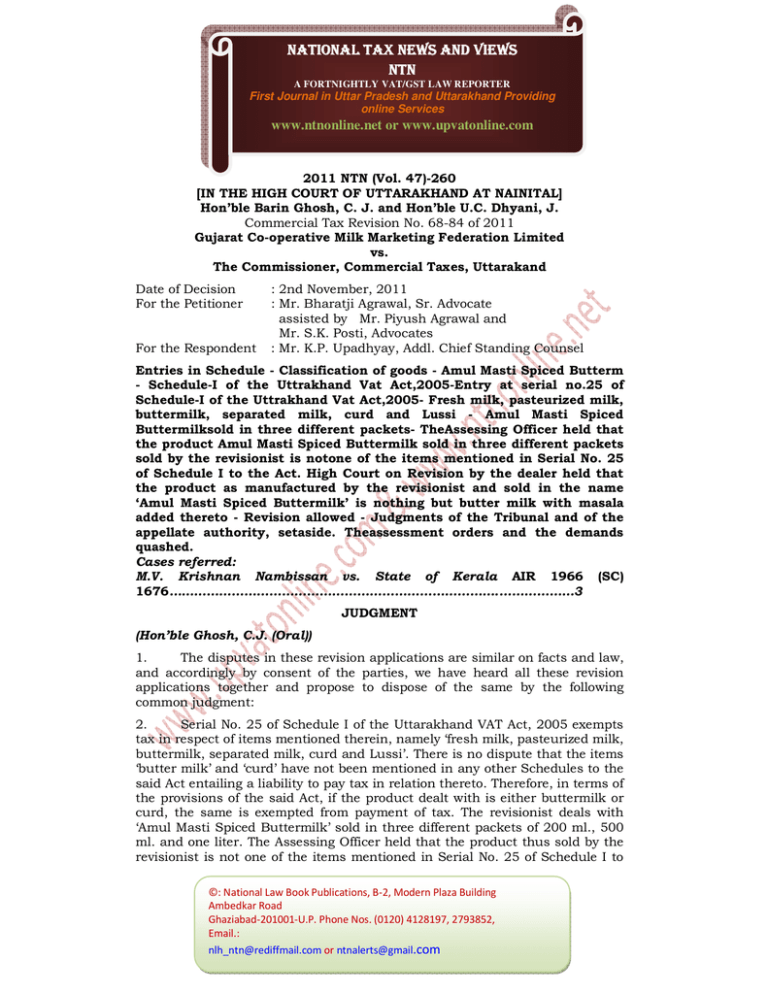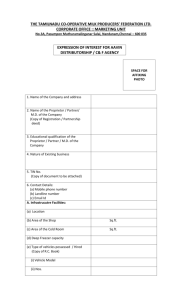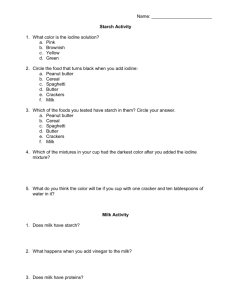2011 NTN(Vol.47)260
advertisement

NATIONAL TAX NEWS AND VIEWS NTN A FORTNIGHTLY VAT/GST LAW REPORTER First Journal in Uttar Pradesh and Uttarakhand Providing online Services www.ntnonline.net or www.upvatonline.com 2011 NTN (Vol. 47)-260 [IN THE HIGH COURT OF UTTARAKHAND AT NAINITAL] Hon’ble Barin Ghosh, C. J. and Hon’ble U.C. Dhyani, J. Commercial Tax Revision No. 68-84 of 2011 Gujarat Co-operative Milk Marketing Federation Limited vs. The Commissioner, Commercial Taxes, Uttarakand Date of Decision For the Petitioner For the Respondent : 2nd November, 2011 : Mr. Bharatji Agrawal, Sr. Advocate assisted by Mr. Piyush Agrawal and Mr. S.K. Posti, Advocates : Mr. K.P. Upadhyay, Addl. Chief Standing Counsel Entries in Schedule - Classification of goods - Amul Masti Spiced Butterm - Schedule-I of the Uttrakhand Vat Act,2005-Entry at serial no.25 of Schedule-I of the Uttrakhand Vat Act,2005- Fresh milk, pasteurized milk, buttermilk, separated milk, curd and Lussi - Amul Masti Spiced Buttermilksold in three different packets- TheAssessing Officer held that the product Amul Masti Spiced Buttermilk sold in three different packets sold by the revisionist is notone of the items mentioned in Serial No. 25 of Schedule I to the Act. High Court on Revision by the dealer held that the product as manufactured by the revisionist and sold in the name ‘Amul Masti Spiced Buttermilk’ is nothing but butter milk with masala added thereto - Revision allowed - Judgments of the Tribunal and of the appellate authority, setaside. Theassessment orders and the demands quashed. Cases referred: M.V. Krishnan Nambissan vs. State of Kerala AIR 1966 (SC) 1676…………………………………………………………………….………………3 JUDGMENT (Hon’ble Ghosh, C.J. (Oral)) 1. The disputes in these revision applications are similar on facts and law, and accordingly by consent of the parties, we have heard all these revision applications together and propose to dispose of the same by the following common judgment: 2. Serial No. 25 of Schedule I of the Uttarakhand VAT Act, 2005 exempts tax in respect of items mentioned therein, namely ‘fresh milk, pasteurized milk, buttermilk, separated milk, curd and Lussi’. There is no dispute that the items ‘butter milk’ and ‘curd’ have not been mentioned in any other Schedules to the said Act entailing a liability to pay tax in relation thereto. Therefore, in terms of the provisions of the said Act, if the product dealt with is either buttermilk or curd, the same is exempted from payment of tax. The revisionist deals with ‘Amul Masti Spiced Buttermilk’ sold in three different packets of 200 ml., 500 ml. and one liter. The Assessing Officer held that the product thus sold by the revisionist is not one of the items mentioned in Serial No. 25 of Schedule I to ©: National Law Book Publications, B-2, Modern Plaza Building Ambedkar Road Ghaziabad-201001-U.P. Phone Nos. (0120) 4128197, 2793852, Email.: nlh_ntn@rediffmail.com or ntnalerts@gmail.com NATIONAL TAX NEWS AND VIEWS NTN A FORTNIGHTLY VAT/GST LAW REPORTER First Journal in Uttar Pradesh and Uttarakhand Providing online Services www.ntnonline.net or www.upvatonline.com the Act. Accordingly the Assessing Officer levied tax on the revisionist. Aggrieved thereby, revisionist went before the appellate authority. The appellate authority held that the product sold by the revisionist is cultured buttermilk. Despite holding that the product is cultured buttermilk, the appellate authority held that the product sold by the revisionist is not buttermilk, which is one of the items mentioned in Serial No. 25 of Schedule I to the Act. The revisionist, in the circumstances, approached the Tribunal. Before the Tribunal one of the contentions of the revisionist was that if the product sold by it is cultured buttermilk, and since the Statute has not made any distinction in between natural buttermilk and water buttermilk, there was no reason for the appellate authority to affirm imposition of tax on the product sold by the revisionist. In addition to that it was contended by the revisionist that the product sold by it is nothing but buttermilk. The revisionist furnished the steps taken by it to prepare the product. Those are as follows: Standardized Pasteurized Toned milk (Fat 3.1% & MSNF 8.7%) Pasteurization of milk 72 degree celcious for 15 Preheat it to 42 degree Celcious –incubation temperature Inoculate DVS culture Mix the culture thoroughly and incubate till pH 4.0 to 4.1 is reached Break the curd and add the required Potable water Mix thoroughly Make a solution of MCG 0019 in plain water using triblender and then add to chhash and after 30 min. add masala separately. Before adding masala, add remaining quantity of water. Mix thoroughly and chill below 10 deg. C UHT processing : at 96-98 degree Celcious/ 4 sec. 110/50 Bar pressure ©: National Law Book Publications, B-2, Modern Plaza Building Ambedkar Road Ghaziabad-201001-U.P. Phone Nos. (0120) 4128197, 2793852, Email.: nlh_ntn@rediffmail.com or ntnalerts@gmail.com NATIONAL TAX NEWS AND VIEWS NTN A FORTNIGHTLY VAT/GST LAW REPORTER First Journal in Uttar Pradesh and Uttarakhand Providing online Services www.ntnonline.net or www.upvatonline.com Down-stream Store at RT till Dispatch after laboratory Clearance It was indicated that at the stage of “inoculate DVS culture” appropriate bacteria is mixed for the purpose of converting pasteurized toned milk processed upto that stage into curd. The process of manufacturing the product in question, as was submitted, did not indicate that at any stage butter or fat is removed from curd either by churning or otherwise. The Tribunal noted the judgment of the hon’ble Supreme Court rendered in the case of M.V. Krishnan Nambissan vs. State of Kerala AIR 1966 (SC) 1676, wherein in relation to buttermilk, the hon’ble Supreme Court observed that the product is obtained after removal of butter from curd by churning or otherwise. The Tribunal held that since no step is taken in the manufacturing process to remove buttermilk or fat from curd, the product manufactured by the revisionist, is an artificial cultured product which is something in between milk and curd and its taste and appearance is tart creamy liquid which is much thicker than the traditional buttermilk. While, however coming to the said conclusion, the Tribunal did not dispute the manufacturing process, as was presented by the revisionist before the Tribunal, and in particular the steps taken in the manufacturing process including the step of “inoculate DVS culture” i.e. mixing of bacteria with milk for the purpose of converting the same into curd. The Tribunal also did not dispute that step of the manufacturing process, as was presented by the revisionist before the Tribunal, where curd is broken and required potable water is added. Therefore, the conclusion that the product is in between milk and curd, in any event, is not acceptable. Furthermore, in the steps of production, as was furnished, which remained undisputed, at the initial stage, material used had been shown as pasteurized toned milk. If pasteurized toned milk has not been converted into curd and accordingly it is still in between pasteurized toned milk and curd, the same will be either pasteurized toned milk or curd. As aforesaid pasteurized milk as well as curd are two of the items mentioned in Serial No. 25 of Schedule I to the Act. 10 3. There cannot be any dispute that buttermilk will come into existence when there is no butter / fat in curd or the quantum of butter / fat is absolutely negligible. At the same time butter / fat less curd will remain curd and will not become buttermilk. Viscosity of such curd is required to be reduced, which is done by adding water. In the traditional method of manufacturing buttermilk recourse is taken to churn curd to remove butter / fat therefrom because that is the easiest process. In course thereof water is also added to reduce the viscosity thereof. Milk contains butter or fat. In order to make the same bereft of butter / fat, the process requires adoption of complicated technology, involving huge expenses. Therefore, the traditional method of producing buttermilk is to convert milk containing fat and butter into curd and thereafter to remove butter / fat from curd by churning the same. There is no known method of removal of fat / butter from curd except by churning, but despite that the hon’ble Supreme Court observed in the ©: National Law Book Publications, B-2, Modern Plaza Building Ambedkar Road Ghaziabad-201001-U.P. Phone Nos. (0120) 4128197, 2793852, Email.: nlh_ntn@rediffmail.com or ntnalerts@gmail.com NATIONAL TAX NEWS AND VIEWS NTN A FORTNIGHTLY VAT/GST LAW REPORTER First Journal in Uttar Pradesh and Uttarakhand Providing online Services www.ntnonline.net or www.upvatonline.com judgment referred to above, churning or otherwise. The object is not to remove butter / fat from the curd, but to remove or reduce the quantity thereof from the original product i.e. milk. The steps of manufacturing, as has been furnished, clearly indicates that the milk which is used as the initial input for the production activity is pasteurized toned milk having a very low fat / butter content. The curd made of such milk, even after churning, may not remove therefrom any further butter / fat, since the quantity of fat or butter is so less in the curd made from milk containing such low quantity of butter / fat. Therefore, despite no butter / fat being removed from curd made out of the pasteurized toned milk, but by adding potable water to the curd which is also a sine qua non for obtaining the product known as buttermilk, a person gets nothing but buttermilk; i.e., milk without butter / fat. We are, therefore, of the view that the product as manufactured by the revisionist and sold in the name ‘Amul Masti Spiced Buttermilk’ is nothing but buttermilk with masala added thereto. 4. The Tribunal has purported to compare buttermilk with UHT milk. However, the Statute has not made any distinction between UHT buttermilk and ordinary buttermilk, whereas it has made specific distinction between UHT milk and fresh milk / pasteurized milk. 5. We accordingly allow the revision applications, and set aside the judgments of the Tribunal and of the appellate authority, and quash the assessment orders and the demands. ---------------------------- ©: National Law Book Publications, B-2, Modern Plaza Building Ambedkar Road Ghaziabad-201001-U.P. Phone Nos. (0120) 4128197, 2793852, Email.: nlh_ntn@rediffmail.com or ntnalerts@gmail.com



